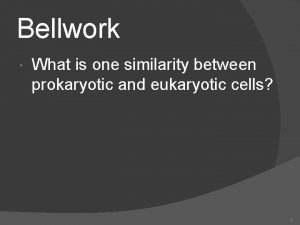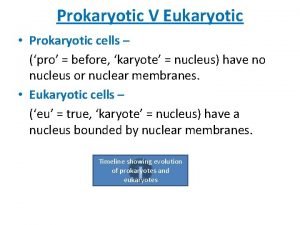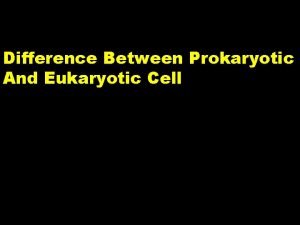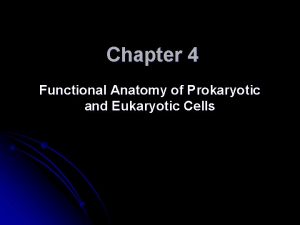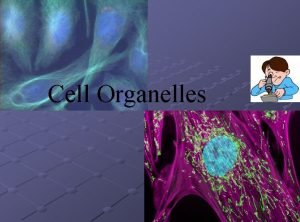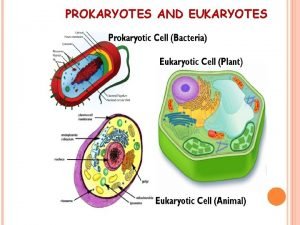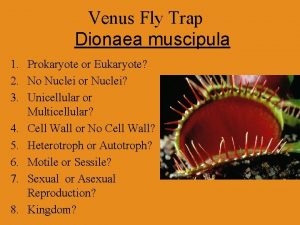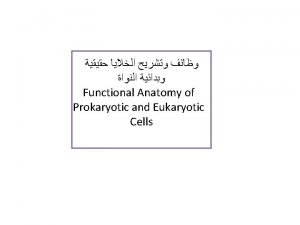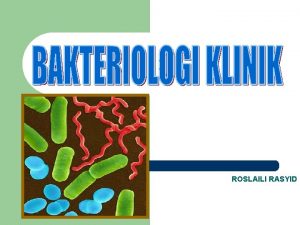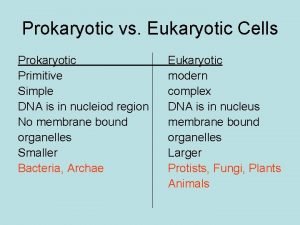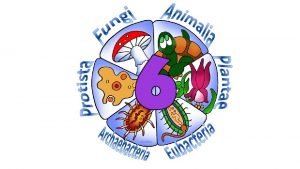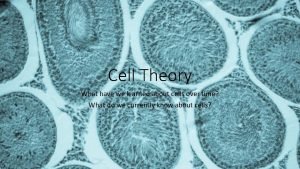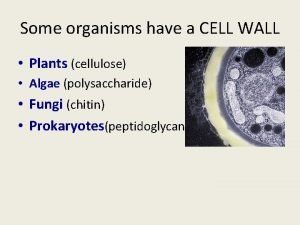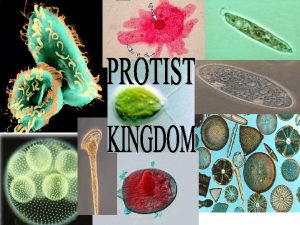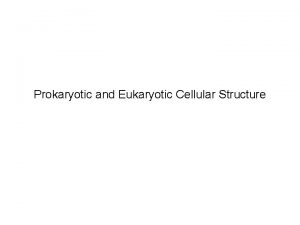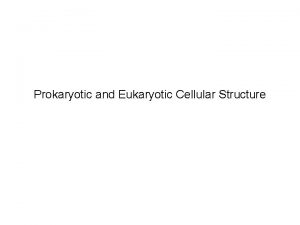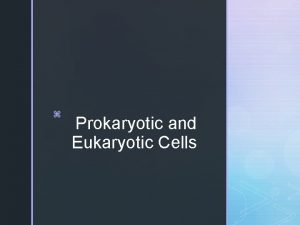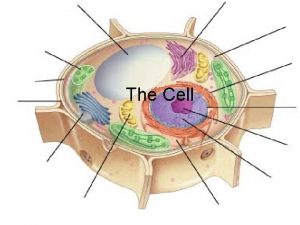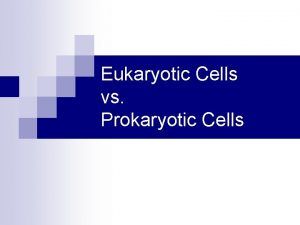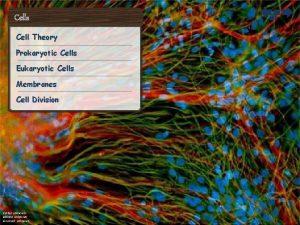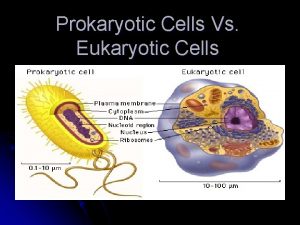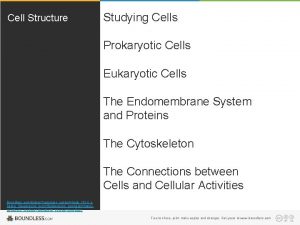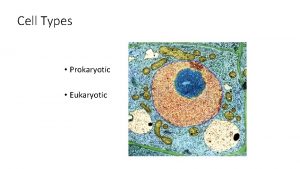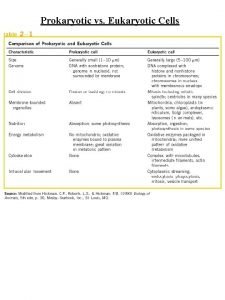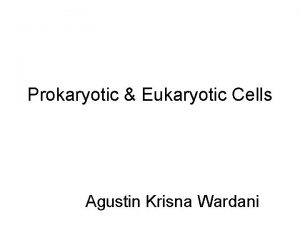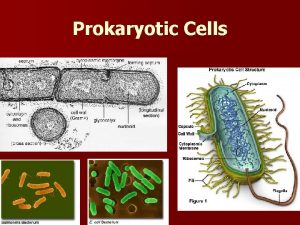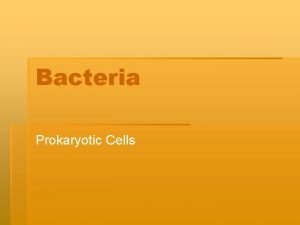Prokaryotic Eukaryotic Cells The Prokaryotes The Simplest and
































- Slides: 32

Prokaryotic & Eukaryotic Cells

The Prokaryotes The Simplest and Most Abundant Living Things

• Approximately 5000 species of bacteria and archaea have been identified, there are probably 10’s of millions of species on Earth. – 400 different species live in your GI tract, 500 in your mouth. – Abundance: There are 1012 bacteria on your skin; and billions in a top of soil.

• Prokaryotes are much more diverse in both habitat and metabolism than the eukaryotes. • However, prokaryotes are not very diverse in body shape or size. • Nearly all prokaryotes are single-cell. • Two major groups: the Eubacteria (sometimes just called Bacteria) and the Archaea (or Archaebacteria).

Prokaryote Structure • Prokaryotes are simple cells • The DNA is loose in the cytoplasm (nucleoid) • The ribosomes are also in the cytoplasm. • In prokaryotes, transcription (synthesis of RNA) and translation (synthesis of proteins) occurs simultaneously. • The cell is surrounded by a membrane • Outside the membrane is a cell wall, and sometimes an outer capsule which can have structures projecting form it. • Bacteria move using flagella

Copyright © The Mc. Graw-Hill Companies, Inc. Permission required for reproduction or display. Ribosomes Cell Wall DNA Cytoplasm Plasma membrane Cell wall Flagellum Pili




Peptidoglycan a polymer of disaccharides (glycan) cross-linked by short chains of amino acids (peptide).

Gram Staining Distinguishes Two Types of Cell Walls in Bacteria Gram-positive cells retain Gram stain more than Gram-negative cells do. Gram-positive cells Gram-negative cells


Bacterial Reproduction • Bacteria reproduce by the process of binary fission (asexual reproduction)

Growth of Bacteria • Under ideal conditions, bacteria grow very rapidly: some double in number every 20 minutes. • Doubling in number: 1 -2 -4 -8 -16 -… is exponential growth.


Eubacteria • The most common types of bacteria • All bacterial peptidoglycan contain Nacetylmuramic acid (component of murein) • Enteric bacteria live in the digestive tracts of animals. Enterics are facultative anaerobes. Best known example: Escherichia coli (E. coli), found in the human gut and also used as a common experimental organism in the lab. Most E. coli strains are harmless, but a few pathogenic (disease-causing) strains exist, causing food poisoning. A common source is ground meat, but it gets on unwashed vegetables as well • Related enteric bacteria: Salmonella, Shigella. Cause food poisoning. Chickens carry Salmonella in their guts instead of E. coli.

Endospore-forming Bacteria • Most of these are in the genus Bacillus (named after their normal shape). • Their spores are very resistant to environmental conditions, and may survive millions of years before they revive. • Anthrax is caused by a Bacillus species. Also is this family are the bacteria that cause botulism (a very bad form of food poisoning) and tetanus (lockjaw--the muscles go rigid).

Nitrifying and Nitrogen-fixing Bacteria • All proteins contain much nitrogen. The atmosphere is 80% nitrogen. However, we can’t directly use atmospheric nitrogen, because it is in the wrong form: N 2. We need it in the ammonia form: NH 3. • Nitrogen fixing bacteria are able to do this conversion. Most of them live in root nodules of certain plants, the legumes, such as alfalfa and soybeans. Farmers plant these crops to enrich their soil by naturally adding ammonia to it. • The nitrogen-fixing bacteria live in the soil and invade the nodules of young plants. • The nitrogen-fixing enzymes are poisoned by oxygen. The root nodules function to keep oxygen away from the bacteria. • Plants also need nitrogen in the form of nitrate, NO 3. Nitrifying bacteria convert ammonia into nitrate.


Archaea • Sometimes called “Archaebacteria” • Genetically different from Eubacteria • One distinguishing characteristic: cell membranes don’t contain fatty acids, but instead use branched molecules called isoprenes. • Three main type: methanogens, extreme halophiles, extreme thermophiles. Archaea Bacteria

• Cell wall: In bacteria murein is the major component of peptidoglycan, whereas pseudomurein in archaea Murein is a unique type of peptidoglycan, a polymer of disaccharides (glycan) cross-linked by short chains of amino acids (peptide). • Cytoplasmic membranes: In bacteria : fatty acid are joined by ester linkage In archaea: branched isoprene molecules are joined by ether linkage.

Methanogens • Methanogens: convert hydrogen and carbon dioxide into methane to generate energy anaerobically. Methanogens are obligate anaerobes: they are killed by oxygen.

Halophiles • Extreme halophiles. Grow in very salty conditions. Colorful bacteria in seawater evaporation beds, Great Salt Lake. • Mostly aerobic metabolism.

Thermophiles • Extreme thermophiles. Live at very high temperatures: ocean hydrothermal vents (up to 113 o C), hot springs in. Yellowstone National Park.

Eukaryotic cells • Prokaryotes are all unicellular, most eukaryotes are multicellular. • Eukaryotic cells are 10 X larger, generally. • ***Prokaryotic cells have one circular piece of DNA located in “nucleoid region”; eukaryotic cells have more DNA, organized into chromosomes and contained in a membrane bound nucleus.

Eukaryotic Cell Contain 3 basic cell structures: • Nucleus • Cell Membrane • Cytoplasm with organelles

Organelles f Very small size f Can only be observed under a microscope f Have specific functions f Found throughout cytoplasm

Organelles Found in Cells Endoplasmic reticulum (rough & smooth) – canals for movement Golgi Bodies – wrap & export proteins Nucleolus – makes ribosomes Lysosomes – digests & gets rid of wastes Ribosomes – makes proteins

The Structures of a Eukaryotic Cell • Nucleus • Mitochondria • Endoplasmic reticulum • Golgi vesicles • Lysosomes • Peroxisomes Image from WH Freeman (www. whfreeman. com/lodish 5 e).

Two Main Types of Eukaryotic Cells Plant Cell Animal Cell

Plant Cell

Animal Cell
 Is bacteria prokaryotic or eukaryotic
Is bacteria prokaryotic or eukaryotic Prokaryotic cells
Prokaryotic cells 4 types of eukaryotic cells
4 types of eukaryotic cells Prokaryotic cell wall
Prokaryotic cell wall Similarities between prokaryotic and eukaryotic cells
Similarities between prokaryotic and eukaryotic cells Differences between prokaryotic and eukaryotic cells
Differences between prokaryotic and eukaryotic cells Similarity between prokaryotic and eukaryotic cells
Similarity between prokaryotic and eukaryotic cells Definetion of cell
Definetion of cell Prokaryotes vs eukaryotes chart
Prokaryotes vs eukaryotes chart Difference between prokaryotic and eukaryotic
Difference between prokaryotic and eukaryotic Similarities between prokaryotic and eukaryotic cells
Similarities between prokaryotic and eukaryotic cells Difference between prokaryotic and eukaryotic cells
Difference between prokaryotic and eukaryotic cells Prokaryotic cell and eukaryotic cell similarities
Prokaryotic cell and eukaryotic cell similarities Anatomy of prokaryotes and eukaryotes
Anatomy of prokaryotes and eukaryotes Prokaryotes vs eukaryotes venn diagram
Prokaryotes vs eukaryotes venn diagram What cell type
What cell type Is animal cell prokaryotic or eukaryotic
Is animal cell prokaryotic or eukaryotic What is eukaryotic and prokaryotic
What is eukaryotic and prokaryotic Life
Life Is a venus fly trap unicellular or multicellular
Is a venus fly trap unicellular or multicellular Prokaryotic cell vs eukaryotic cell
Prokaryotic cell vs eukaryotic cell Monera procariota
Monera procariota Is protozoa prokaryotic or eukaryotic
Is protozoa prokaryotic or eukaryotic Is bacteria prokaryotic or eukaryotic
Is bacteria prokaryotic or eukaryotic Are amoeba prokaryotic or eukaryotic
Are amoeba prokaryotic or eukaryotic Eukaryote
Eukaryote Prokaryotic vs eukaryotic
Prokaryotic vs eukaryotic Manitole
Manitole Lipshutz bodies
Lipshutz bodies Animalia eukaryotic
Animalia eukaryotic Eukaryotic cell
Eukaryotic cell Do seedless plants have cell walls made of cellulose
Do seedless plants have cell walls made of cellulose All protists are ________
All protists are ________






